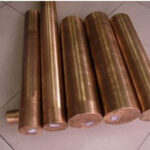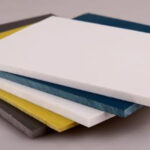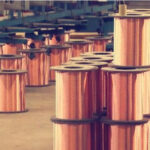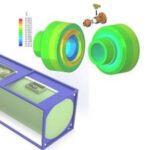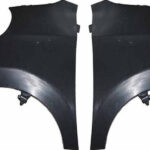In the 1982 musical comedy “Victor Victoria”, Julie Andrews sang a high profile at the end of her character’s Paris cabaret show. She supported the notes, and the champagne glasses in the whole room broke. This is a good illustration of how high-pitched or high-frequency sounds separate materials. But did you know that you can use high-frequency sound to bond materials together? Ultrasonic welding technology is used to assemble products in many industries-from medical equipment to sports shoes to cars.
The upper material of this New Balance sneaker is assembled by ultrasonic welding instead of traditional sewing methods
Generally, you can use fasteners such as nails, screws, or threads to bond the material. This applies to metal, wood, fabric and plastic. For many plastics, glue is used. The glue forms a chemical bond between the glue itself and the surface of the plastic material. Metals can be held together by heating other metals as adhesives, such as lead solder in electrical connections. Alternatively, the metal can be directly melted (welded); or the metal can be directly melted. Once the molten metal surface cools, the metal will stick together. Welding usually requires an open flame or torch to reach the high temperatures required to melt the metal surfaces together. Therefore, this can be an expensive process for some manufacturing tasks.
A new, more cost-effective welding method was introduced in the 1940s. Ultrasonic welding technology uses high-frequency sound waves and pressure to bond metals together and requires less energy than traditional welding. Ultrasonic metal welding was developed from the 1950s to the 1990s because the electronic equipment used in the equipment became more and more complex, and computers could control the process. Since then, this technology has been truly applied in the field of plastics.
In this article, we will study the equipment and physical process of ultrasonic welding, how New Balance uses it to make sports shoes, and the advantages and disadvantages of the technology. First, let’s take a closer look at how sound waves combine materials such as metal and plastic.
1. Ultrasonic welding and friction
Table of Contents
Ultrasonic welding mechanism diagram
Rub your hands together quickly. Did you notice anything? Are they warming up? If you hit the metal surface quickly and repeatedly with a hammer, you will find that the place where the hammer hits the metal will also become hot. In both examples, the heat is caused by friction. Now, imagine rubbing your hand or hitting that hammer thousands of times per second. The frictional heat generated can significantly increase the temperature in a very short time. Basically, high-frequency sound (ultrasound) causes rapid vibrations in the material to be welded. Vibration will cause materials to rub against each other, and friction will increase the temperature of the contact surface. This rapid frictional heat creates conditions for the materials to bond together.
Ultrasonic welding equipment has four main parts. The power supply converts low-frequency electricity (50-60 Hz) into high-frequency electricity (20-40 kHz; 1 kHz = 1000 Hz). Next, the transducer or converter converts high-frequency electricity into high-frequency sound (ultrasound). The booster makes the ultrasonic vibration greater. Finally, the horn or ultrasonic generator will focus the ultrasonic vibration and transmit it to the material to be welded. In addition to these parts, there is an anvil on which the welding material is stacked and fixed. There are also methods to apply force (usually air pressure provided by a pneumatic piston) during the welding process to hold the material together.

So, what materials and industries can take advantage of this smart process? Ultrasonic welding of plastics is widely used in the manufacture of electronics, medical equipment and automotive parts. For example, ultrasonic welding is used to make electrical connections on computer circuit boards and to assemble electronic components such as transformers, motors, and capacitors. Medical equipment such as catheters, valves, filters and masks are also assembled using ultrasonic welding. The packaging industry uses this technology to make films, assemble test tubes and blister packs. Even Ford Motor Company is exploring the use of ultrasonic welding to manufacture the aluminum chassis of automobiles.
2. Ultrasonic welding step by step
Ultrasonic welding process diagram
The basic process of ultrasonic welding can be described by the following steps:
1. Place the parts to be welded in the anvil or fixture.
2. The horn is in contact with the parts to be welded.
3. Apply pressure to keep the horn in contact with the welding material and fix it together.
4. The horn emits ultrasonic vibration to heat the material. The vibration moves up and down or left and right by less than one millimeter.
5. These materials are welded together.
6. The welding head is retracted and the welding material can be removed from the anvil.
The welding time, applied pressure and temperature are controlled by the computer or microprocessor in the welding equipment. What actually happens during welding depends on the nature of the material. In metals, ultrasonic vibrations are transmitted parallel to the plane of the material. The frictional heat raises the temperature of the metal surface to about one-third of the melting temperature, but it does not melt the metal. Instead, heat removes metal oxides and thin films from the surface. This allows metal atoms to move between the two surfaces and form bonds that hold the metal together.
For plastics, the vibration is perpendicular to the plane of the material, and frictional heat raises the temperature enough to melt the plastic. Plastic molecules mix together and form bonds. After cooling, the plastic surfaces are welded together. The welding time can vary, but the welding can be formed in as little as 0.25 seconds.
Factors that vary in ultrasonic welding include the frequency of the sound wave (usually 20, 30, or 40 kHz), the pressure applied to hold the material together, and the time the ultrasound is applied (a fraction of a second or more). One second).
The ultrasonic welding techniques described so far are suitable for similar materials (metals, plastics). But what about dissimilar materials? Let’s solve this problem by looking at how New Balance uses ultrasonic welding to assemble sports shoes.
3, the role of ultrasonic welding
The assembly of sports shoes: After applying the hot melt film to the artificial suede, press it
Look at a pair of sneakers. Traditional shoes may be made of a single material (such as canvas or suede), while many sports shoes have multiple materials, such as lightweight plastic polymers, suede or synthetic suede, and mesh. These composite materials make the shoes light, flexible, durable and breathable. For example, one style of New Balance sneakers has an upper consisting of three parts.
1. A synthetic suede pattern called the upper-the upper constitutes most of the upper of the shoe, including the toe of the shoelace, the tongue and the eyes.
2. A synthetic suede pattern called saddle eye row-saddle eye row contains the top two holes to strengthen shoelaces and reduce wear.
3. A layer of mesh cloth-the mesh cloth surrounds the heel part of the upper and the upper part of the opening around the ankle.
But how to put these materials together? Most commonly, shoe companies sew materials together. However, about two to three years ago, New Balance set about making the upper part of the shoe upper without stitching. After experimenting with polymer adhesive films and irons, they proposed a method of using ultrasonic welding to make this part of the shoe.
In order to assemble the upper part of the shoe, the staff must first use a piece of artificial suede material. They used an iron press to bond a thin layer of hot-melt film to the back of the material. Next, the ultrasonic welding assembly presses the patterned upper into the suede material. Similarly, a similar ultrasonic welding machine also squeezed the saddle-shaped eye row from another piece of artificial suede. The shape of the upper is cut from the suede. The saddle eye row and the mesh material are welded to the shoe upper by ultrasonic. In these processes, the frictional heat from the ultrasonic welding machine melts the hot melt film, thereby bonding the saddle eye row and the mesh material to the upper. Then, the finished shoe upper is shaped and glued to the sole and heel using an aqueous solvent.
New Balance senior product developer Kenneth Straka (Kenneth Straka) said that the ultrasonic welding method increases productivity by saving time. Ultrasonic welders not only dissipate heat more evenly than iron presses, but they also heat and cool faster. Therefore, the assembly process requires fewer steps and is faster than traditional sewing methods.
Now that we have understood how to use ultrasonic welding to bond various materials, let us look at the advantages and disadvantages of this technology.
4, why use ultrasonic welding method
Assembly of sports shoes: bonded synthetic suede
Compared with traditional methods, ultrasonic welding has many advantages. First, compared to other methods, welding is performed at low temperatures. Therefore, manufacturers do not need to spend a lot of fuel or other energy to reach high temperatures. This makes the process cheaper. It is also faster and safer.
This process only takes a fraction of a second to a few seconds. Therefore, it can be completed faster than other methods. In fact, it can bond plastics faster than glue. For example, a transponder chip is installed in a new smart key in a car. The car can only start after sensing the chip. To make the key, put one end of the metal key blank and the chip into the half of the plastic top. Place the other half on top of them and glue to the lower half. This bonding is usually done with glue, which takes some time to cure. Ultrasonic welding can accomplish the same task in less than a second.
Ultrasonic welding does not require flammable fuel and open flames, so it is a safer process compared to other welding methods. Workers must not come into contact with flammable gases or toxic solvents. In electronic products, copper wires are usually connected to electrical contacts on the circuit board through solder. Using ultrasonic welding can accomplish the same task in a short time without exposing workers to the fumes of the negative lead solder. Although exposure to high-frequency sounds may damage the hearing of workers, this potential hazard can be easily reduced by installing the ultrasonic welding machine in a safety box or cage and/or using ear protection devices.
Finally, ultrasonic welding is as strong and durable as traditional welding of the same material-this is just one of the reasons why this method is used in automobile manufacturing. In order to make cars lighter and more fuel-efficient, automakers are using aluminum as the main body metal. Compared with traditional welding, ultrasonic welding can be used to bond metals in less time and at a lower temperature.
But ultrasonic welding does have its limitations. First of all, the depth of the weld is less than one millimeter, so this process is most suitable for thin materials such as plastics, metal wires or metal sheets. It is impractical to weld steel beams of buildings by ultrasonic method. Second, it works best when welding similar materials (for example, similar plastics or similar metals). As you can see in New Balance shoes, ultrasonic welding of dissimilar materials requires additional material-in the case of New Balance shoes, this is a film that can be glued between the artificial suede and the mesh.
Despite these limitations, the popularity and potential of ultrasonic welding is still growing.
Link to this article:The difference between ultrasonic welding and traditional welding
Reprint Statement: If there are no special instructions, all articles on this site are original. Please indicate the source for reprinting:https://www.cncmachiningptj.com/,thanks!
 3, 4 and 5-axis precision CNC machining services for aluminum machining, beryllium, carbon steel, magnesium, titanium machining, Inconel, platinum, superalloy, acetal, polycarbonate, fiberglass, graphite and wood. Capable of machining parts up to 98 in. turning dia. and +/-0.001 in. straightness tolerance. Processes include milling, turning, drilling, boring, threading, tapping, forming, knurling, counterboring, countersinking, reaming and laser cutting. Secondary services such as assembly, centerless grinding, heat treating, plating and welding. Prototype and low to high volume production offered with maximum 50,000 units. Suitable for fluid power, pneumatics, hydraulics and valve applications. Serves the aerospace, aircraft, military, medical and defense industries.PTJ will strategize with you to provide the most cost-effective services to help you reach your target,Welcome to Contact us ( [email protected] ) directly for your new project.
3, 4 and 5-axis precision CNC machining services for aluminum machining, beryllium, carbon steel, magnesium, titanium machining, Inconel, platinum, superalloy, acetal, polycarbonate, fiberglass, graphite and wood. Capable of machining parts up to 98 in. turning dia. and +/-0.001 in. straightness tolerance. Processes include milling, turning, drilling, boring, threading, tapping, forming, knurling, counterboring, countersinking, reaming and laser cutting. Secondary services such as assembly, centerless grinding, heat treating, plating and welding. Prototype and low to high volume production offered with maximum 50,000 units. Suitable for fluid power, pneumatics, hydraulics and valve applications. Serves the aerospace, aircraft, military, medical and defense industries.PTJ will strategize with you to provide the most cost-effective services to help you reach your target,Welcome to Contact us ( [email protected] ) directly for your new project.
Link to this article:The difference between ultrasonic welding and traditional welding
Reprint Statement: If there are no special instructions, all articles on this site are original. Please indicate the source for reprinting.:Cnc Machining,Thank!^^

